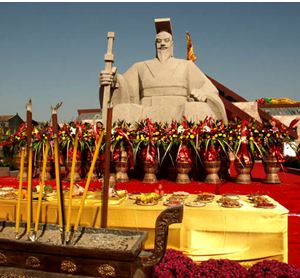Emperor HuangDi Achievements
Huangdi, or the Yellow Emperor, is a legendary Chinese sovereign and cultural hero. He is said to be the ancestor of all Huaxia Chinese. According to many sources he was one of the legendary Three Sovereigns and Five Emperors. Tradition holds that he reigned from 2697–2597 BCE (100 years of age) or 2696–2598 BCE (98 years of age). He is regarded as the founder of Chinese civilization.
Described as a great inventor, the Yellow Emperor improved the livelihood of the nomadic hunters. He taught people how to build shelters, to tame wild animals and to grow the five Chinese cereals. He also invented carts, boats and clothing. It is amazing that so many great leaps forward took place in just one man’s lifetime. He is remarkable in that way.
Cultural Contributions
He unified the tribes in China. He created the lunar calendar, taught people how to plant crops, created words, invented music instruments, and medical system of knowledge. He created the time calculation system which we still use in our lunar calendar.
Mathematics:
HuangDi created mathematical systems to calculate weights and measurements.
Military Strategy:
He used the same knowledge I present on this site for his military to gain strategic advantage in the battle field. His systematic use of military strategy won over 50 wars. Amongst his epic battles was the Battle of Zhuolu and the battle of Banquan (both are very interesting and important aspects of Chinese mythology.
Music:
He created the flute made from bamboo and set the pentameter system of music theory that is used in all music today. Prior to that music systems were very elementary.
Fabric and clothing:
The Yellow Emperor’s principal wife Léizǔ taught people how to weave silk from Bombyx mori silkworms and to dye clothes. Prior to his reign clothing was very primitive.
Medicine:
The Yellow Emperor’s Inner Canon on internal medicine, supposedly the world’s oldest medical book, is the basis of traditional Chinese medicine.
Written word:
At the Yellow Emperor’s request, historian Cāng Jié created the first Chinese character writing system, changing the way history was recorded in the following dynasties through the use of Oracle bone script. The system later became the basis for many scripts.
Use of metals and other structural materials in all forms of commerce and war:
He cast copper to make money, built boats, cars, weapons, arrows and housing.
Spiritual civilization
He invented the first use of astronomy in China, the concepts of yin and yang, the zodiac, the theory of six decades dating, text, pictures, books, musical instruments, medicine, ritual, weddings, funerals, coffins, graves, offering Ding, altars, shrines, divination and so on.
Political civilization
He established a formal country structure: The country was designated by nine states. each state was designated by city borough. There were 120 official positions to manage the country, make laws for officers and people. His ideological and moral concepts were to only use people of good moral character and talent for official positions. He implemented the rule of law.
Agricultural taxation system
The Yellow Emperor established a method of farming wherein the land was specially divided into nine deliniated sections. Eight plots belonged to the farmers and surrounded the ninth which was specifically farmed for tax purposes (The Tian Mu System).
He is also credited with the development and invention of the following:
HuangDi not only invented a great many new needs but he organized life in the use of items that were previously used without organization. He is credited with the further development, implementation of and/or invention of: thread production, the textile loom, manufacture of clothes, shoes, hats, tents, blankets, guns, specially processed fur, armor, flags, helmets, pottery, the manufacture of “fired” bowls, plates, kettles, steamers, dishes, spoons and stoves.
In smelting and manufacture: copper, tripods, specially produced knives/weapons, coins, bronze mirrors and clocks.
In Construction and Architecture: the construction of palaces, temples, courts, halls, castles, buildings, doors and shrines
In Transportation: manufacturing of boats and car type vehicles, the compass guided car, the mileage measurement car.
In military weapons: the manufacture of knives, guns, arrows, crossbows, flags, flag of five directions, horns, special ladders, swords, and so on.
In daily life: cooked food, porridge, rice, wine, meat, rulers, measurement for weight and size, desk, ink, carpet, seal, beads, lamps, beds, seats, etc…
Put simply, under HuangDi life became organized and civilized. There was order and a way of doing things with the right materials and tools.

